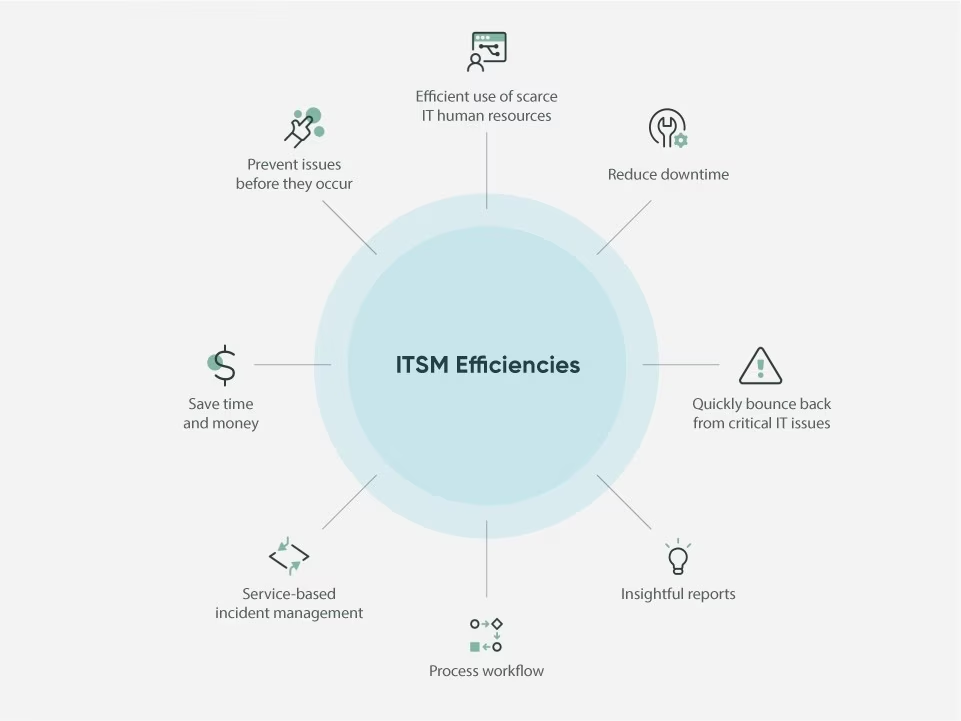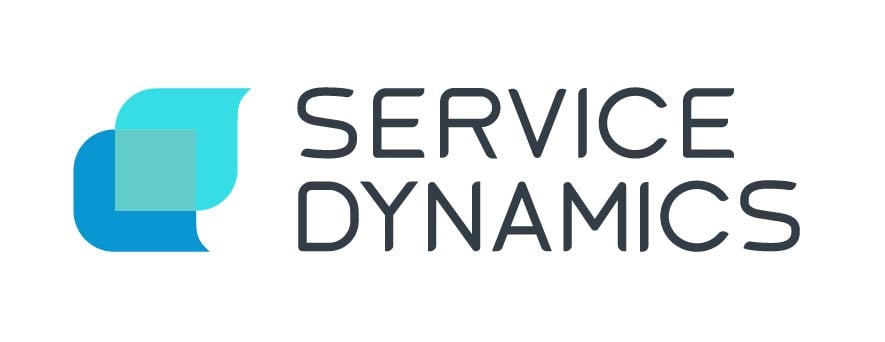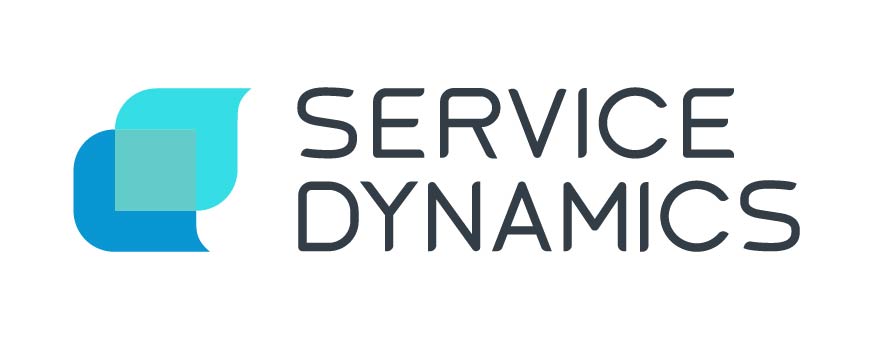Information technologies now encompass and incorporate tasks and responsibilities across entire organisations. Managing these services can be challenging, and end-users expect businesses to be up to the task. Businesses depend on IT Service Management (ITSM) to effectively coordinate these tasks and processes, while ensuring that they are providing real value to the end user.
The main idea behind ITSM is the delivery of IT as a service. This goes beyond traditional IT support - instead it is far more inclusive. ITSM describes the processes and tools IT teams use to manage IT services, end to end, and covers all information technologies within an organisation.
Because IT service management is a collection of policies and processes for the management and support of IT services throughout their entire lifecycle, ITSM helps improve an enterprise’s efficiency and increase employee productivity.
![]()
The right IT framework directly leads to effective collaboration and oversight. Many organisations find themselves championing either ITSM/ITIL or DevOps. But committing completely to one approach or the other can potentially be problematic.
ITSM/ITIL and DevOps are not mutually exclusive; each have their own goals, functions and benefits. Below is a overview and high-level definition, as well as a look into how these frameworks relate to one another:
ITSM
ITSM is a strategic approach to IT management, with a focus on delivering value to customers. ITSM clearly defines the roles and responsibilities of every individual and department with regard to IT services. It allows for increased productivity, lower costs, and improved end-user satisfaction.
ITIL
ITIL is a framework for IT service management that provides detailed best practices for IT functions to align with an organisation’s business outcomes. ITIL stands for IT infrastructure library. ITIL is one of several best-practices frameworks for ITSM, providing the necessary tools and techniques to deliver IT services effectively.
The ITIL framework has been through several iterations, with the latest referred to as ITIL 4.
DevOps
Where ITIL streamlines service management with the main focus on customer satisfaction - DevOps is a philosophy for IT development and delivery. It joins development and operations teams, with the objective of improving communication and collaboration within an entire organisation.

Why is ITSM important?
ITSM provides a number of benefits for the entire business, the IT department and the employees. It is the bridge that connects IT professionals within an organisation to the end users.
What are the benefits of ITSM for business?
- Increased agility - Quickly adapt to changes and innovation.
- Reduced costs - Easily visualise workflows, leading to improved efficiency and cost savings.
- Fewer IT problems and improved response - Decrease IT problems and respond to incidents quickly, reducing the associated cost and disruption.
- Easy compliance - Ensure compliance with regulatory requirements.
- Better service - Improve satisfaction rates for end users.
What are the benefits of ITSM for IT?
- Improved productivity - Aligned goals backed by reliable services ensure that more gets done with fewer problems.
- Increased user satisfaction - IT is delivered as a service with the needs of the user as the primary focus.
- Better process scaling - Processes are more efficient, allowing organisations to handle more IT development without reducing quality.
- Faster incident detection and response - Organisations enjoy improved IT visibility, identifying incidents and responding quickly before they can become an issue.
What are the benefits of ITSM for Employees?
- Improved IT support - 24/7 IT support to perform better and do more. Employees also enjoy a clearer understanding of available IT services and how to use them correctly.
- Omni-channel experience - Access relevant information and make support requests from any device, at any time, from anywhere in the world.
- Clearer roles and responsibilities - Teams can understand who is responsible for what tasks and are more accountable and informed.
- Improved business alignment - Visibility to what the business and the end users need, and why.
![]()
How does ITSM deliver these benefits?
IT service management improves efficiencies across the board. Technology is an integral part of IT processes, but it should not necessarily be the primary focus. ITSM is more encompassing, expanding to include business objectives in addition to traditional IT objectives.
Incident management
Manage and track incidents (the disruption of normal operations), as well as service requests for new services, software, or hardware. ITSM incident-management handles the entire incident-management process to restore service to customers as quickly as possible. The ability to prioritise incidents and service requests according to business impact allows staff to focus their efforts where they can be most effective.
Problem management
Problem-management processes remove defects from the IT infrastructure, eliminate recurring incidents, and stabilise the environment. Effective problem management solutions allow you to streamline incident investigations, from detection to eradication.
Change and release management
ITSM tracks scheduled and planned infrastructure changes, including process management and planning capabilities. Change implementation is quicker and more consistent, with risks and errors minimised.
Service-level management
Track service-level commitments with customers and from vendors, so management can pinpoint weaknesses and take corrective action.
Request management
Manage and follow up on service requests, including requests to reset passwords, install new workstations, update personal data, or access information. Request management helps ensure that important requests are always moving forward.
Configuration management
Track all configuration items in your IT system. Identify, verify, and maintain critical configuration information for hardware, software, personnel, and documentation.
Configuration management gives your IT teams a reliable repository for IT component information and establishes clear relationships between IT infrastructure components and services.
Continual improvement management
Request ITSM improvement opportunities and implement phases and tasks to track performance goals and measure success. Connect improvement to your overall business strategy and improve service efficiency.
Talent management and workflows
Place the right people with the right skills and knowledge into the roles that best suit them. Support your business objectives by correctly positioning the most talented employees to provide the best possible service.
A common example of ITSM services in action is an IT service desk or help desk. Using a virtual agent, an online help desk can answer questions about common topics. For example:
- “How do I reset my password?”
- “Why is the network slow?”
- “How do I connect to a VPN remotely?”
- “How can I get a new laptop?”
What should you look for in an ITSM solution?
When choosing the ITSM solution for your organisation, there are a number of factors that need to be taken into consideration :
Simplified setup and activation
A complex, confusing setup process is a major barrier to adoption. Your ITSM software and tools should include intuitive activation instructions, backed by self-service portals and knowledgeable support agents.
Ease of use
ITSM is designed to provide IT services across your entire organisation. It needs to be user friendly and intuitive to promote complete adoption throughout your various departments. It should include a self-service portal where users can find solutions and reliable information, and track progress on any issues that may arise.
Flexibility and adaptability
Your ITSM software exists to support you and your business. As such, it needs to be able to grow and change with you, scaling to accommodate growth, adapting to changing resolutions and processes, and providing consistent value even as your IT teams evolve.
Powerful collaboration features
Collaboration across departments leads to increased efficiency and faster issue resolution. Your ITSM solution should facilitate inter-departmental coordination by providing a single, intuitive platform for all parties to work through.
FAQs
When selecting an ITSM solution, prioritise simplified setup and activation—complex processes create barriers to adoption. The software should be user-friendly and intuitive to encourage adoption across all departments, including a self-service portal where users can find solutions and track issues.
Look for flexibility and adaptability so the solution can scale with your business growth and adapt to changing processes. Powerful collaboration features are essential, as collaboration across departments leads to increased efficiency and faster issue resolution.
Your ITSM solution should provide a single, intuitive platform for all parties to work together effectively, backed by knowledgeable support agents to help your teams get the most value from the system.
ITSM allows you to easily visualise workflows, leading to improved efficiency and cost savings. By managing incidents more effectively, organisations can decrease IT problems and respond quickly to issues, reducing both the cost and disruption associated with downtime.
The framework improves productivity by aligning goals with reliable services, meaning more work gets done with fewer problems. Additionally, ITSM provides better visibility into IT operations, allowing teams to identify and resolve incidents before they escalate into major issues.
The ability to prioritize incidents based on business impact ensures staff focus their efforts where they'll be most effective, maximizing resource utilization.
Implementing ITSM standardises processes, which leads to increased efficiency, reduced operational costs, and higher accountability within the IT department.
By moving from a reactive "fire-fighting" mode to a proactive service delivery model, organisations experience improved customer satisfaction and a significant reduction in service outages and disruptions.
No, successful ITSM is about much more than just technology; it requires a balanced combination of people, processes, and technology. While software tools (like ServiceNow or Ivanti) are enablers, ITSM relies heavily on cultural change, defining clear workflows, and ensuring that the people involved understand their roles in delivering service value.


